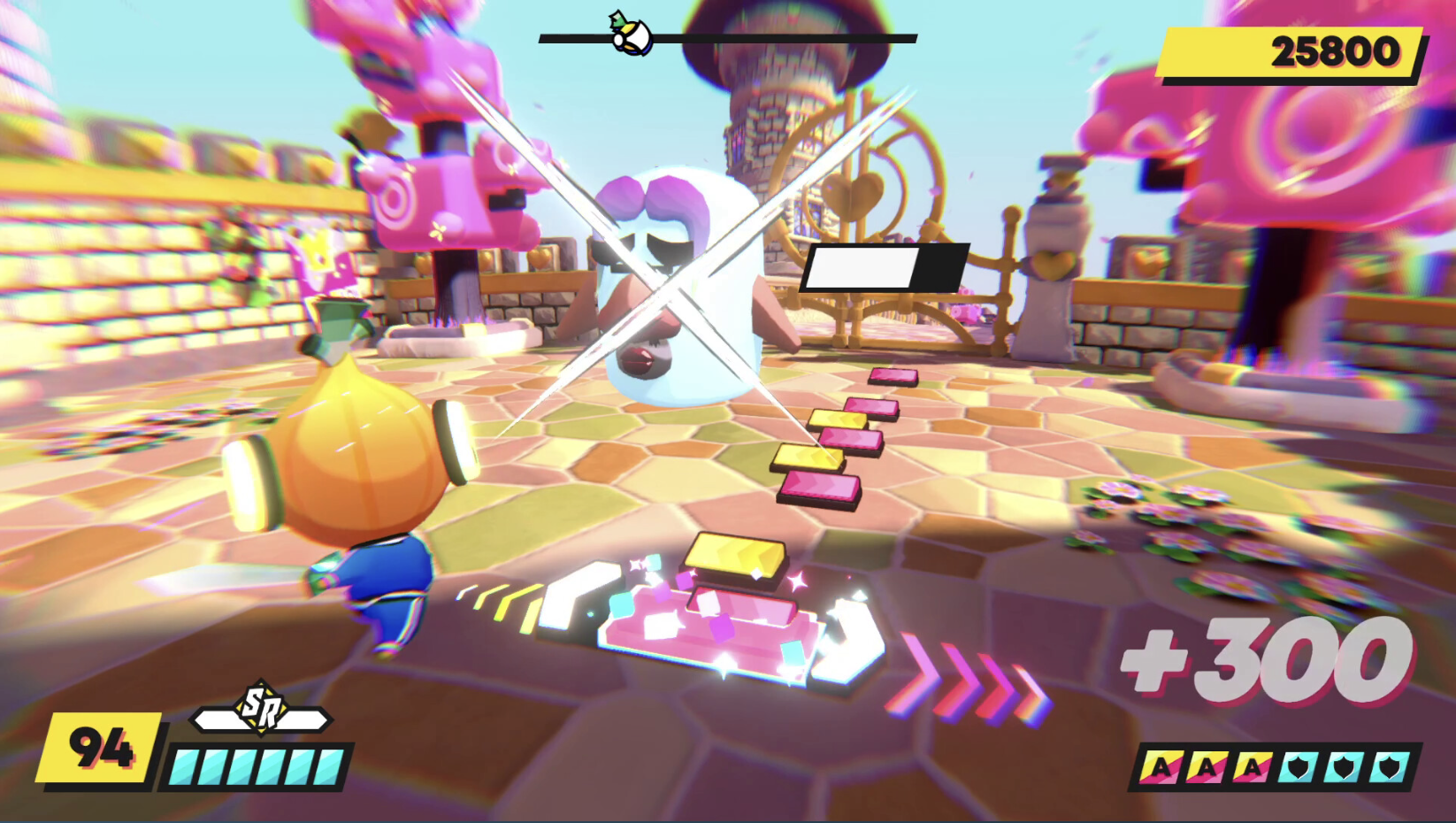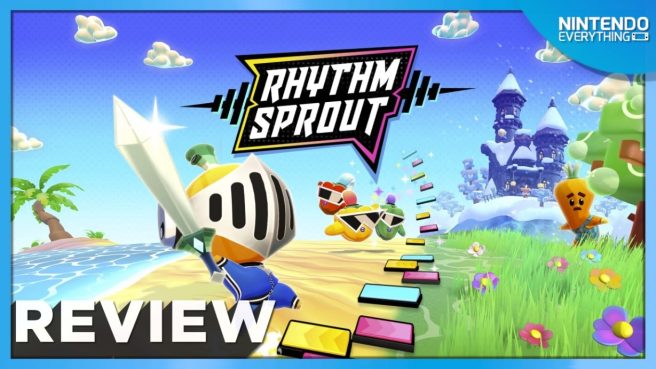[Review] Rhythm Sprout
System: Switch
Release Date: February 1, 2023
Developer: SURT
Publisher: tinyBuild
It takes a certain type of creative mind to look at the vegetables on display in their grocery store produce aisle and decide, “finally – the protagonist for my story-driven rhythm game!” That level of kookiness is the driving force behind Rhythm Sprout, a delightfully bonkers rhythm-action game in which an onion wearing headphones and a tracksuit slaughters various edible enemies to the beat of a wide range of music. As the debut release from Norwegian developer SURT games, Rhythm Sprout’s creative concept has maintained my interest ever since its initial reveal, but how does its beat-based gameplay live up to the rest of the experience?
I’ve loved playing rhythm games ever since I first picked up Rhythm Heaven on my DS back in 2009, and while I can absolutely enjoy a more serious experience from time to time, I’ll always be a bit partial to games that lean into the quirkier side of the genre. While there are several notable upcoming indie projects that are trying to echo the microgame format of Rhythm Heaven, Rhythm Sprout takes a different approach. Here, our plucky vegetable protagonist runs ever forward through a variety of cartoony environments, with every successful hit of a note moving our soldier forward a step. As enemies appear onscreen throughout the course of a stage, our spritely sprout will slash its sword and dodge enemy attacks to the beat. It feels reminiscent of Game Freak’s classic HarmoKnight, minus the platforming elements of that game.

Rhythm Sprout’s thirty music-based stages are framed around a simple but often hilariously-written story that feels ripped out of an episode of a Saturday-morning cartoon. You play as “The Chosen Onion,” who is tasked by the easily annoyed King Brock with protecting the Vegetable Kingdom from the Army of Bad Sweets, led by the mysterious King Sugar Daddy. Oh, and as a complete afterthought, he also wants you to deliver a strongly worded letter to his missing daughter, Princess Cauliflower, who he seems only marginally concerned about. Each level begins and ends with cutscenes in which Sprout interacts with a wide range of food-themed characters, from a concerned farmer (who is a carrot) and a seedy tropical resort manager (who is an apple). If this amuses you, as it does for me, you will likely fall in love with Rhythm Sprout very quickly.
There are a lot of chuckle-worthy jokes scattered throughout, and the writing is made funnier by the game’s overall presentation. Characters speak in warbled gibberish voices a-la Animal Crossing, and little things like letting the player respond to questions and be absolute jerks is a wonderful touch. The art direction is simple but vibrant, and I loved seeing the wide variety of environments that each new stage introduced. I really could sense that a lot of love was poured into crafting an engaging setting to match the premise of the game, and I think the developers absolutely nailed it. The Switch version is also well-optimized and stable to play, and I didn’t experience any technical issues during my playthrough.
Of course, a rhythm game is only as good as its music, and fortunately, Rhythm Sprout’s soundtrack is catchy, varied, and occasionally absurd. You’ll hear everything from disco to metal during your playthrough, but I particularly loved the more off-the-wall tracks. My favorite was by far a song that was entirely set to the rhythm of a villain’s evil laugh – I was grinning from ear to ear, and there are plenty of fun surprises like that in store throughout the adventure.

Unfortunately, it’s the actual moment-to-moment gameplay where I’m a little more mixed on the experience. To be clear, I like a lot of what Rhythm Sprout sets out to do – the game is more focused on the player’s technical execution of hitting notes to the beat rather than needing to nail complicated multi-button combinations or more gimmicky types of notes. You’re really only ever hitting one button at a time, and there are only three types of notes that players have to manage – pink notes correspond with face buttons, yellow notes with the d-pad, and blue notes with the shoulder buttons. Hit notes to move forward through the stage; miss too many blue notes, and your HP will drain, ending the stage. Later levels introduce notes that need to NOT be hit, but beyond that, it’s simple in terms of mechanics that need to be learned.
With that said, Rhythm Sprout is a difficult experience, sometimes overwhelmingly so at times. This is mostly by design – despite the game’s cute aesthetic, notes are often delivered at incredible speed, to the point where often it’s the case that every beat in a track has a corresponding note that needs to be hit. This game feels like it was built for players who enjoy the challenge of being bombarded with difficult note patterns that are supposed to be mastered with practice. There are certainly some more approachable stages scattered throughout the game’s primary campaign, but these are the exception rather than the rule. It makes a broader recommendation a bit more difficult, as I think many players will be enamored with the style of Rhythm Sprout but frustrated when they realize that the difficulty does not align with the aesthetic. The game would benefit greatly by introducing additional options for players who are looking for that – while there’s a Beginner’s Mode that simplifies the types of notes players will need to hit, there’s no traditional Easy difficulty with simpler beat mapping, nor is there any way to slow the tempo of a song or even a practice mode. There are plenty of ways to make the experience harder, though, like randomizing note patterns. So, while some players may really enjoy the challenge, it’s a difficult game to recommend unless you are specifically seeking a high level of challenge.

I mentioned that this difficulty is mostly by design, which is fine, but where it becomes more problematic for me is where there are, what I feel, are fundamental oversights in how Rhythm Sprout works that lead to unintentional frustrations. For starters, Rhythm Sprout feels like a game that was initially designed for keyboard controls, and I found playing on the Switch to be less than ideal. My main issue is that I found the game’s default button mapping to not be a great fit for the ergonomics of the Switch’s controllers. Regardless of whether I was playing with the Joy-Con in a split configuration, attached to their grip, or attached to the Switch in handheld mode, I always felt like I had to contort my hands in awkward ways to be able to feasibly reach all the required buttons. The Pro Controller was probably the best experience, but as that’s not something all Switch players own, it’s not a great solution. I’ve played plenty of other rhythm games on the Switch where I haven’t had this issue, which is why I’m inclined to believe that this is less of an issue with the Switch’s design and more of an issue with the design of the game. I would have liked to see some alternate control schemes in-game or a way to remap buttons without going into the system settings.
I also think Rhythm Sprout needs more visual cues during its stages that align with the rhythm of their songs. Some stages have items in the background that will bounce to the beat, but some don’t, and I think the lack of consistency makes some stages artificially trickier than others. Alternatively, many rhythm games that have notes coming at you on a linear path also display some type of track – think back to the guitar fret in Guitar Hero, for example. Rhythm Sprout does not do this, and in combination with the nontraditional camera angle, this makes it more complicated than necessary to visually gauge the speed and space between notes.

My final issue was with how Rhythm Sprout handles input latency, or lag. Latency is one of the unfortunate realities of any game where precise timing is critical, and it’s always going to vary from person to person, display to display, sound system to sound system. To an extent, all a developer can really do is provide a wide range of options to help players easily compensate for whatever latency their gaming setup may have. To its credit, Rhythm Sprout attempts to do this – you can offset latency with a few different sliders, and even set up some presets if you want. But I found the auto-calibration tool to be inconsistent, often delivering wildly different results on the same audio-visual setup. I admit that I’m not perfect and that there’s certainly the chance that I screwed something up myself, but again – I play a good variety of rhythm games on Switch, and have never had this hard of a time dialing in latency in, say, Superbeat Xonic or Taiko No Tatsujin. That’s an indication to me that the tool itself may need some more work.
Despite these gripes, I had a lot of fun with Rhythm Sprout! It’s a blast from start to end, and scorechasers will likely enjoy replaying stages to unlock costumes and weapon skins for Sprout. I loved the wacky worldbuilding and over-the-top antics that peppered every second of the story, not to mention the bonus “prequel campaign” that has our protagonist taking down a shady company that is committing tax fraud. There’s a lot to love with the package, and while I really want to see some of the game’s issues addressed over time, I think the overall package is a great option for rhythm fans looking for something fresh.
The Verdict

Rhythm Sprout is one of the most charming, silly, and flat-out entertaining rhythm games to come out of the indie scene in a while, and its unique premise and style had me laughing and smiling throughout my playthrough. A catchy and original soundtrack propels the game forward, and the focus on technical mastery is a refreshing approach for the genre. While I’d like to see more accessibility options added as well as some improvements to how the game handles its controls and latency, players who are excited for a challenge will find a lot to love with Rhythm Sprout.
Rhythm Sprout copy provided by the publisher for the purposes of this review.
